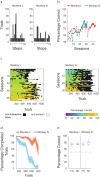Macaque monkeys learn and perform a non-match-to-goal task using an automated home cage training procedure
- PMID: 33514812
- PMCID: PMC7846587
- DOI: 10.1038/s41598-021-82021-w
Macaque monkeys learn and perform a non-match-to-goal task using an automated home cage training procedure
Abstract
In neurophysiology, nonhuman primates represent an important model for studying the brain. Typically, monkeys are moved from their home cage to an experimental room daily, where they sit in a primate chair and interact with electronic devices. Refining this procedure would make the researchers' work easier and improve the animals' welfare. To address this issue, we used home-cage training to train two macaque monkeys in a non-match-to-goal task, where each trial required a switch from the choice made in the previous trial to obtain a reward. The monkeys were tested in two versions of the task, one in which they acted as the agent in every trial and one in which some trials were completed by a "ghost agent". We evaluated their involvement in terms of their performance and their interaction with the apparatus. Both monkeys were able to maintain a constant involvement in the task with good, stable performance within sessions in both versions of the task. Our study confirms the feasibility of home-cage training and demonstrates that even with challenging tasks, monkeys can complete a large number of trials at a high performance level, which is a prerequisite for electrophysiological studies of monkey behavior.
Conflict of interest statement
The authors declare no competing interests.
Figures



Similar articles
-
Home-Cage Training for Non-Human Primates: An Opportunity to Reduce Stress and Study Natural Behavior in Neurophysiology Experiments.Animals (Basel). 2025 May 6;15(9):1340. doi: 10.3390/ani15091340. Animals (Basel). 2025. PMID: 40362154 Free PMC article. Review.
-
Macaque monkeys learn by observation in the ghost display condition in the object-in-place task with differential reward to the observer.Sci Rep. 2019 Jan 23;9(1):401. doi: 10.1038/s41598-018-36803-4. Sci Rep. 2019. PMID: 30674953 Free PMC article.
-
Standardized automated training of rhesus monkeys for neuroscience research in their housing environment.J Neurophysiol. 2018 Mar 1;119(3):796-807. doi: 10.1152/jn.00614.2017. Epub 2017 Nov 15. J Neurophysiol. 2018. PMID: 29142094
-
Effects of reward size and context on learning in macaque monkeys.Behav Brain Res. 2019 Oct 17;372:111983. doi: 10.1016/j.bbr.2019.111983. Epub 2019 May 26. Behav Brain Res. 2019. PMID: 31141723
-
Role of the social actor during social interaction and learning in human-monkey paradigms.Neurosci Biobehav Rev. 2019 Jul;102:242-250. doi: 10.1016/j.neubiorev.2019.05.004. Epub 2019 May 6. Neurosci Biobehav Rev. 2019. PMID: 31071362 Review.
Cited by
-
Home-Cage Training for Non-Human Primates: An Opportunity to Reduce Stress and Study Natural Behavior in Neurophysiology Experiments.Animals (Basel). 2025 May 6;15(9):1340. doi: 10.3390/ani15091340. Animals (Basel). 2025. PMID: 40362154 Free PMC article. Review.
-
Home-Enclosure-Based Behavioral and Wireless Neural Recording Setup for Unrestrained Rhesus Macaques.eNeuro. 2023 Jan 11;10(1):ENEURO.0285-22.2022. doi: 10.1523/ENEURO.0285-22.2022. Print 2023 Jan. eNeuro. 2023. PMID: 36564215 Free PMC article.
-
Dedicated Representation of Others in the Macaque Frontal Cortex: From Action Monitoring and Prediction to Outcome Evaluation.Cereb Cortex. 2022 Feb 8;32(4):891-907. doi: 10.1093/cercor/bhab253. Cereb Cortex. 2022. PMID: 34428277 Free PMC article. Review.
-
Group-based, autonomous, individualized training and testing of long-tailed macaques (Macaca fascicularis) in their home enclosure to a visuo-acoustic discrimination task.Front Psychol. 2022 Nov 29;13:1047242. doi: 10.3389/fpsyg.2022.1047242. eCollection 2022. Front Psychol. 2022. PMID: 36524199 Free PMC article.
-
Apex and ApeTouch: Development of a Portable Touchscreen System and Software for Primates at Zoos.Animals (Basel). 2022 Jun 28;12(13):1660. doi: 10.3390/ani12131660. Animals (Basel). 2022. PMID: 35804559 Free PMC article.
References
-
- Hopper LM. Cognitive research in zoos. Curr. Opin. Behav. Sci. 2017 doi: 10.1016/j.cobeha.2017.04.006. - DOI
Publication types
MeSH terms
LinkOut - more resources
Full Text Sources
Other Literature Sources

